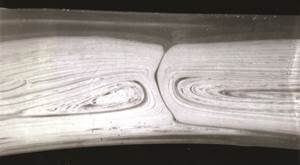Making Older Hydraulic Injection Machines More Energy Efficient
Processor Strategies: Motor Controllers
In an era when no manufacturer can afford to overlook readily achievable cost savings, American injection molders are at last getting serious about energy efficiency. Among the many routes to this end, a number of molders are exploring one that has been around for decades but is getting a new look, thanks to improved technology.
It is well accepted that electric servo drives are more energy efficient than hydraulics for injection molding presses. But all-electric machines cost more and some molders still prefer the way hydraulic machines operate. Driving an hydraulic pump with an electric servo motor is a cost-effective energy saver for new machines but is considered too costly for retrofit. A less expensive alternative, said to provide energy usage very close to electric servo drives, is a variable-speed, variable-frequency drive (VFD).
“If I had an older hydraulic machine that I wanted to keep, I wouldn’t hesitate to retrofit it with a VFD,” says Per Flem, CEO and owner of custom molder Recto Molded Products in Cincinnati. He has employed a wide variety of energy-saving technologies in his plant (as reported in our Nov. 2010 On-Site story). In the past year, he installed a SyncroSpeed variable-speed motor controller on a 440-ton Milacron toggle press and it achieved 37% overall energy savings.
Variable-speed motor controllers got some attention back in the 1980s, but they “got a bad name,” according to Flem, because of faulty technology at the time. He says things are different today. Flem is a user—and his Cincinnati Process Technologies (CPT) subsidiary is a regional installer for other molders—of the SyncroSpeed motor controller from CCS Technology Ltd. of the U.K. (syncrospeed.com), represented here by Plastic Metal USA Ltd., Bayside, N.Y. (plasticmetalusa.com). This device uses an inverter drive from Schneider Electric and a Bosch Rexroth PLC. It works with the existing motor and pump, but varies the speed of the motor according to the instantaneous hydraulic demand in the cycle. Typical systems cost anywhere from $18,000 to $28,000, depending on the number and size of motors on the machine. “ROI in many cases is 8 to 18 months,” says Ribert Knaster, president of Plastic Metal USA.
The real secret to the SyncroSpeed system is said to be its software, which divides the molding machine cycle into as many as 30 “states” (usually 10 to 20 states are sufficient) such as clamp opening and closing, core and ejector movements, injection, screw recovery, etc. During installation, a technician profiles the control signals of the molding machine and the parameters are programmed into the SyncroSpeed. After that, the system needs no further attention. The motor controller reportedly has no effect on cycle time. “It’s invisible to the operator,” says Flem.
Around 100 SyncroSpeed systems have been sold in North America—one molder has 30 of them, according to Knaster. Together, these devices have accumulated over 3.5 million hr of operation. CCS Technology says energy savings range from 35% to over 55%, depending on the machine and cycle. Longer cycles, 25 sec or more, provide the most savings. Machines over 400 tons are good candidates because of the larger motors. Also, variable-volume pumps save less—more like 10% to 20%—though machines with mixed variable and fixed pumps have saved over 30%.
Another user of this system is custom molder Xten Industries, Kenosha, Wis. It installed four SyncroSpeed controllers on 725-ton presses and saved 34% in energy overall (graph), amounting to 220,000 kWh and $24,000 annually. Xten retrofitted four more presses the following year.
Ipex Inc., a molder of PVC pipe fittings Bermondsey, Ont., retrofitted a 880-ton Engel press with three 75-hp motors in 2010 and saved 48%. A 500-ton Engel with two 60-hp motors saved 43%. And a 530-ton Haitian press with one 100-hp motor saved 37%. Engineering director Rod Huels comments, “The systems delivered just as they said they would.”
Related Content
How to Get Rid of Bubbles in Injection Molding
First find out if they are the result of trapped gas or a vacuum void. Then follow these steps to get rid of them.
Read MoreHow to Optimize Pack & Hold Times for Hot-Runner & Valve-Gated Molds
Applying a scientific method to what is typically a trial-and-error process. Part 2 of 2.
Read MoreKnow Your Options in Injection Machine Nozzles
Improvements in nozzle design in recent years overcome some of the limitations of previous filter, mixing, and shut-off nozzles.
Read MoreWhat to Do About Weak Weld Lines
Weld or knit lines are perhaps the most common and difficult injection molding defect to eliminate.
Read MoreRead Next
Understanding Melting in Single-Screw Extruders
You can better visualize the melting process by “flipping” the observation point so that the barrel appears to be turning clockwise around a stationary screw.
Read MoreHow Polymer Melts in Single-Screw Extruders
Understanding how polymer melts in a single-screw extruder could help you optimize your screw design to eliminate defect-causing solid polymer fragments.
Read MoreAdvanced Recycling: Beyond Pyrolysis
Consumer-product brand owners increasingly see advanced chemical recycling as a necessary complement to mechanical recycling if they are to meet ambitious goals for a circular economy in the next decade. Dozens of technology providers are developing new technologies to overcome the limitations of existing pyrolysis methods and to commercialize various alternative approaches to chemical recycling of plastics.
Read More











.png;maxWidth=300;quality=90)














